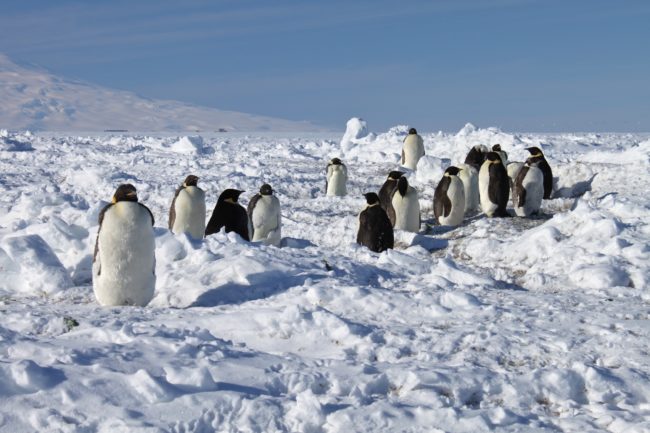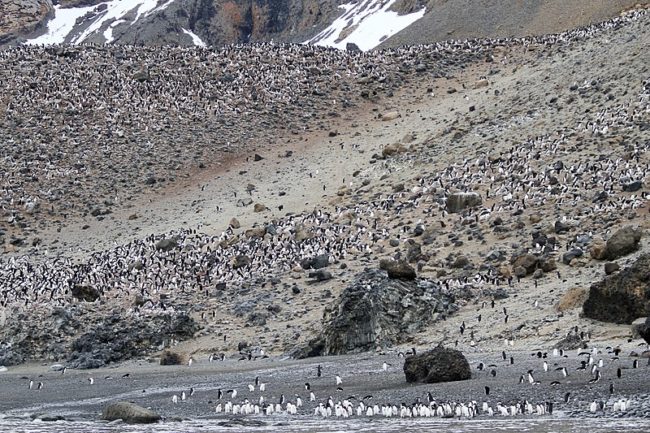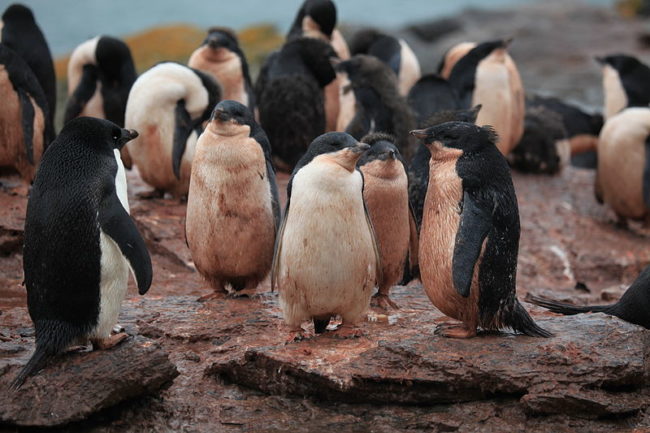Internet postings about the percentage of Antarctica made up of penguin pee are everywhere. We knew about the birds previously, but it made us wonder how penguins pee and why they do it?
We understand that this is an unusual topic, and most people responded that penguins do pee. Is it not true that anything less would be surprising?
As such, do penguins have to pee? In reality, Penguins cannot pee. They are mammals without a urethra and bladder.
Instead of turning waste into urea, they turn it into uric acid. It is secreted as a semi-solid white paste, as waste alongside a penguin’s poop. Penguins can do this excitingly and crazily!
Thus, to address the question, how do penguins pee, the given information provides a rapid solution.
However, Today, we will dive deep and understand – ” why penguins don’t pee? What is the color of their pee? and how they drink water?” Are you ready? Let’s go!
Why don’t penguins pee?

Before understanding why penguins do not pee, we need to remember that they cannot fly too. Yet they still look like birds in many ways.
On the other hand, Penguins are seabirds and cannot pee like all other birds. Yes, all birds do not pee; instead, they dispose of their waste similarly to penguins.
When we were investigating how penguins urinate, we came across a lot of disinformation, just like any other question: someone says something, and someone else cites it completely differently somewhere else.
But, we received an intriguing response to our query in the end. Penguins cannot pee. The reasons are evident and factual, not based on speculation or supposition.
For Instance – Humans have a urethra and a bladder, which take nitrogenous waste from the kidneys and excrete or expel urea.
It will be very toxic to humans if it stays inside our bodies. Hence a human needs to urinate.
In the same way, birds and penguins do not have the same waste system. Penguins are classified as uricotelic, meaning that their metabolic mechanism for discarding the waste is different from humans and other mammals.
Penguins have neither a urethra nor a bladder. That means they do not need to urinate.
Instead of turning nitrogenous waste in their bodies into urea, which needs to come out as urine, their kidneys turn it into uric acid.
Uric acid is less toxic in a Penguin’s body. As they do not have a urethra or bladder, the uric acid created by the metabolic process passes out of the penguin via its anus.
It is mixed with feces to form a semi-solid waste, which looks like a white paste. So, penguins do not pee, and it explains why they poop. The same goes for all other birds.
What color does a penguin’s pee look like, and do they pee in the water?
Like other flying birds, you can see that sometimes it is white, and sometimes it is brown, green, or black. The white part is urine, and the other colors are feces.
What are feces? A feces is waste matter remaining after a food has been digested, discharged from the bowels, excrement.
Penguins do not sweat and only excrete uric acid, a white paste-like, foul and concentrated waste in the water. They do not urinate like mammals because it would be a water waste.
The urine of a penguin is white, in contrast to the typical yellow-amber color of normal urine in mammals.
While mammals excrete nitrogenous waste primarily in urea, penguins convert this to uric acid or guanine.
Most people have witnessed bird droppings that resemble a white, cream-colored, or yellow, opaque deposit found on patios, windows, and garden furniture, but have you wondered why the color is as such?
It obtains its nutrition by eating marine critters like Krill, fish, and smaller organisms.
The excreta of penguins can vary in color, consistency, and quantity. A penguin’s wastes are an excellent measure to determine its general health and well-being.
Hence, if you look closely at the penguin’s feces, you’ll notice that the white paste is the darkest component, and pee is the clear watery part of the excrement.
Does Antarctica contain much penguin pee?
According to the above question, there is no penguin excrement or pee in Antarctica.
Penguins do not pee and pass waste in uric acid and a semi-solid white goo.
According to some web sources, penguin pee accounts for 3% of all ice in Antarctica; that’s a lot of urine and feces.
This information, however, is not adequately substantiated. There could be a brilliant scientist who could figure out something nearly as difficult as that to measure it.
Perhaps the material emphasizes that everything in Antarctica freezes, even penguin feces, because of the cold.
Therefore they came up with a certain number calculating the amount of penguin’s waste that builds up in Antarctica over some time.
Antarctica is enormous. It has a total area of 14.2 million square kilometers. Antarctica has just 3% of the world’s natural ice made by penguin excrement, but 90% of the planet’s natural ice. Unfortunately, this ratio does not exist in reality.

If penguin feces and urine account for 3% of Antarctica’s surface area, then penguin waste accounts for 426000km2 of the continent’s surface area.
How can penguins pee?
Since penguins do not pee, nitrogenous waste is turned into uric acid instead of urea by their bodies rather than excreted as urine.
Penguins drink water the same way other birds do: by swallowing it. Wherever available, penguins drink water: melting ice, the sea, or the seas.
To keep hydrated, penguins, even chicks, can even consume snow. Although this isn’t unusual, they have no other option except to ingest salt water when the water is freezing.
Although saltwater absorbs some aspects of water and keeps them hydrated, penguins can get rid of any extra salt in their bodies in other ways, such as through their supraorbital gland.
Even though penguins do not pee, they may eliminate extra water or salt by purifying it in their sweat glands and secreting it via their beak.
Is it true that penguins pee while they poop?
Penguins, like other birds, create nitrogenous waste products that they must defecate. Ammonia is a byproduct of both pee and poop.
Ammonia is converted to urea by mammals, including humans, and excreted in the urine.
Penguins convert ammonia to uric acid, which appears as a thick, white paste that we commonly refer to as bird poop.
Although they pass white paste, which is authentic penguin excrement, these birds do this to avoid walking with the weight of a full bladder.
Penguins have just one exit for their reproductive, digestive, and urine tracts – the cloaca – they pee and poop simultaneously, and their pee comes while they defecate.
As a result, the green and brown traces in the white uric acid paste equal human excrement.
Do penguins have a bladder?
Humans and other mammals store urine in the bladder, but what about penguins?
Penguins, like ostriches, do not have a bladder and thus do not produce urea.
Urea is one of the components found in urine. And it’s stored in the bladder before being discharged by the urethra.
On the other hand, Penguins convert harmful ammonia waste into highly concentrated uric acid, or guanine, which prevents adaptation to watery urine storage by keeping the urine as light as possible while walking and swimming in the water.
Could 3% of Antarctica be penguin urine?
The scientists have uncovered ten additional emperor penguin colonies by following penguins’ skid prints on Antarctic ice through satellite pictures.
Since penguins congregate in enormous colonies over a small area for months at a time, the snow around them quickly turns filthy.

Scientists at the British Antarctic Survey state that “Guano is visible from space. Penguins live in large colonies in the Antarctic where it snows heavily and is quite filthy, as seen in satellite photographs.”
Is the urine of penguins good for the environment?
Penguins, unlike mammals, do not urinate or sweat and instead excrete uric acid in the form of a white paste.
According to recent studies conducted on a vast penguin colony, penguin feces may be contributing to increased global warming, such as in Antarctica.
To investigate the effects of glacier retreat and penguin’s waste on greenhouse gas emissions, scientists from the University of Copenhagen in Denmark visited South Georgia, home to the world’s largest colony of king penguins.
Although penguins feed heavily on nitrogen-rich food such as fish and krill, their Guano (poop) or white paste produces large amounts of nitrous oxide, popularly known as laughing gas.
That means the influx of penguins increases nitrous oxide in the atmosphere. Scientists claim that this nitrous oxide contributes heavily to global warming.
By consuming food, penguins release nitrogen in their feces on the ground. According to a study, this nitrogen is converted to nitrogen oxide by soil bacteria.
“The highest emissions are over 100 times those of the fertilized Danish sector.” Professor Bo Elberling of the University of Copenhagen’s Department of Geology and Natural Resource Management explains, “It’s intense – not least because nitrous oxide is 300 times more polluting than carbon dioxide.”
In this case, nitrous oxide emissions are not enough to impact the earth’s overall energy budget.
Is there any role of penguin’s pee in fertilization?
As we know, their penguins do not urinate, but they excrete the white paste, and when they do it on land, their wastes accumulate and dry out. It turns into Guano and is also full of nutrients like nitrogen and phosphorous.
According to the outcomes of a new study published in the journal, Trends in Ecology and Evolution, this generates a whopping $473 million each year for the fertilizer industry.
This number is just a conservative estimate based on the market price of guano fertilizer. Guano is even more valuable to fishing communities, the tourism industry, and planetary health.
Do penguins have a lot of pee?
Penguins do not sweat or excrete sweat; instead, they excrete uric acid, a white paste, yet they have a lot of waste to eliminate. We say this because we have scientific facts to back it up. Thus, let’s have a look at why they pee so often.
In the summer of 2007, scientists from Denmark’s University of Copenhagen visited South Georgia (representing the world’s largest breeding colony of king penguins, with about 150,000 breeding pairs living in giant colonies) to investigate how glaciers retreat and penguin activity affects greenhouse gas emissions.
The penguins spend their day eating Krill, squid, and fish, feeding their chicks, and producing Guano (poop) or white waste. Penguins prey heavily and tend to crowd together.

That is to say; white waste accumulates in variable levels to the point that it can be observed from space using satellites. It is the best way to detect possible penguin colonies!
As an example, Roberts et al. (2017) outline a great way to accomplish this. They used the 84.5 grams of Guano produced by a gentoo penguin per day to analyze the impact of a volcanic eruption on the size of a penguin colony that dates back 8,500 years!
Final Thoughts
Instead of converting waste to urea, they convert it to uric acid. It is found, as a semi-solid white paste alongside penguin excrement, as waste.
Simply put, penguin feces is awe-inspiring. It not only provides penguins with a haven from the weather and a place to raise babies, but it also serves as a very efficient source of fertilizer for people.
More than that, a penguin’s secretion gives us a wealth of information about different penguin species and can even tell us how diverse the animals in the area are.
The facts to get cleared with answers are indeed interesting. I hope you got the response to the factual discussion that happened one day with your friends or family where you left the space filled with sheepish smiles.
Image Source:
Do penguins pee? by creozavr / Pixabay License
Antarctica’s natural ice and penguins by Eli Duke / CC BY
Guano is visible from space by Grant.C / CC BY
Penguins colonies with their waste by Liam Quinn / CC BY
Reference Links:
- https://www.natience.com/do-penguins-pee/
- https://www.mysticaquarium.org/fbliveanswers-3/
- https://www.pinguins.info/Engels/Waterhuishouding_eng.html
- https://animals.mom.com/penguins-drink-3006.html
- https://boardgamestips.com/collectible-card-games/do-penguins-poop-and-pee/
- https://www.cbc.ca/radio/quirks/sep-29-2018-narcolepsy-shows-the-importance-of-sleep-bird-voiceboxes-neutron-star-nuclear-pasta-and-more-1.4840708/question-why-is-bird-poop-white-1.4840710
- https://www.audubon.org/news/what-makes-bird-poop-white
- https://birdfact.com/articles/do-birds-pee
- https://m.slashdot.org/story/119853
- https://www.news18.com/amp/news/buzz/king-penguins-poop-a-lot-and-this-may-not-be-good-for-our-environment-2692439.html
- https://edition.cnn.com/2020/05/19/world/king-penguins-laughing-gas-scn-trnd/index.html
- https://www.nrdc.org/stories/overlooked-importance-penguin-poop-fulmar-feces-and-gull-guano
- https://www.penguinsinternational.org/2020/02/09/the-usefulness-of-penguin-poo/
Penguins aren’t mammals.
Penguins are birds.